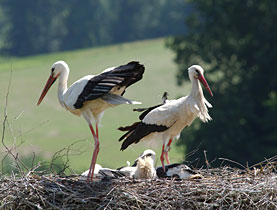High-tech pigeons reveal navigation secrets

Researchers may be one step closer to finally solving the scientific mystery of how homing pigeons are able to find their way home over long distances.
A team lead by a Zurich-based scientist has created a tiny device that reads the birds’ brain waves while they fly, showing that pigeons appear to recognise places of interest as they navigate.
Homing pigeons have been used for centuries to carry messages and have been known to cover hundreds of kilometres in a single journey. Previous studies had suggested that they used indicators such as the position of the sun in the sky, the Earth’s magnetic field and even their sense of smell to find their way around.
It is also known that they use visual landmarks. But which processes in the brain help them pinpoint where they are going has not been clear. This is where the pioneering work of an international team, led by Zurich University’s Alexei Vyssotski, comes in.
Through a series of experiments conducted on the type of homing pigeons once used by the Swiss army, scientists were able to see what happens in the birds’ brains as they fly.
“We have recorded for the first time the brain activity of a free flying navigating animal,” Vyssotski told swissinfo.ch. The results of the study are published in the latest edition of the Current Biology journal.
Brainwaves and GPS
To peer into the world of the pigeons, Vyssotski, a research fellow at Zurich University’s Institute of Neuroinformatics, developed a device called the neurologger. The apparatus weighs just two grams and contains an electroencephalograph (EEG), a system that records electrical activity in the brain.
The team then outfitted 26 test birds with neurologgers and mini global positioning systems before setting them free on the Italian coast of the Mediterranean Sea at distances of up to 30 kilometres from their home lofts.
The data revealed a surprise. Vyssotski said that low frequency brain waves, which his team had been concentrating on in earlier studies, were not as important as thought.
“Unexpectedly, it has been found that middle and high frequency brain waves correlate with the animal behaviour better,” he said.
Land and sea
Scientists found that these middle and high frequency brain waves were relatively inactive when the pigeons flew over the sea but were much busier when they approached the coastline. When the team released the birds in a suburb, the same frequencies spiked as the birds passed over features such as roads.
“The middle frequency activity is the most reliable indicator that visual stimulation has happened. So it means when a pigeon looks at something with attention, this activity is increased,” Vyssotski said.
High frequency waves showed an even more intriguing pattern, he added. Their activity seemed to reflect the bird’s recognition of places it had visited before.
“In other words, the activation of these oscillations [of the brain waves] may be associated with some memory processing or some other high level brain function,” Vyssotski said.
Pigeons in flocks produced fewer of the brain waves than those flying alone, which Vyssotski believes shows that the birds share the navigation work when flying together.
Birds of a feather…
The test pigeons also took a lot of interest in a farm and a barn, which seemed to be irrelevant to finding their way home. Researchers solved the puzzle by visiting these locations, where they discovered colonies of wild pigeons, which must have caught the other birds’ attention.
Experts have been quoted in the scientific media as saying they were excited by the findings. Oxford University biologist Dora Biro told the New Scientist magazine that the neurologger was “an amazing technical feat in its own right”. The device has also been praised for opening a new window into the avian brain.
Vyssotski’s experiments were conducted in areas that were familiar to the birds. A next step, he says, will be to see how they react to completely new environments and to find out how pigeons make their navigation decisions.
Isobel Leybold-Johnson in Zurich, swissinfo.ch
“The EEG Responses to Visual Landmarks in Flying Pigeons” study was published in Current Biology on June 25.
It involved a team from Switzerland, Russia and Italy.
The neurologger is not just for birds. Alexei Vyssotski is also involved in studies of sloths, mice, as well as dolphins and seals.
Pigeons are part of the Columbidae family. Homing pigeons are a domesticated type of rock pigeon that have been bred to be able to find their way home over extremely long distances.
The wild rock pigeon has an innate homing ability, meaning that it will return to its nest and mate.
Homing pigeons are called carrier pigeons when they are used to carry small messages.
They were used to relay news of the conquest of Gaul to Rome, brought news of Napoleon’s defeat at Waterloo to Britain and were used extensively for message carrying in the two World Wars.

In compliance with the JTI standards
More: SWI swissinfo.ch certified by the Journalism Trust Initiative



You can find an overview of ongoing debates with our journalists here . Please join us!
If you want to start a conversation about a topic raised in this article or want to report factual errors, email us at english@swissinfo.ch.